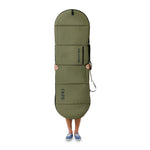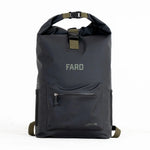
Do you want to start surfing but don't know where to begin? Surfing is not just a sport but a science, and in this post, we will break it down so you can easily understand how surfing works. So, what's the wait? Let's get started!
Learning the Basics
Before you learn about surfing itself, it's important to take a look at the equipment you'll be using and the waves you'll be riding. Getting the basics down is the first step to understanding the mechanics behind surfing!
Anatomy of a Surfboard
A contemporary surfboard is made up of a handful of components. Here's a list of every piece that makes a surfboard:
-
Nose: The nose of the board, also known as the front or tip, plays a role in how easily you can paddle and catch waves.
-
Deck: The deck is the middle of the board, where you stand while surfing.
-
Rails: The rails are the board's edges that affect its maneuverability in the water.
-
Tail: The tail of the board is located at the back and comes in various shapes like squash, round pin, or swallowtail - each style has a different effect on your performance on different wave conditions.
-
Fins: The fins are on the underside of your board - these small components influence stability and control while riding waves.
Types of Surfboards
There is a surfboard design out there for every surfer. Surfboards come in various shapes and sizes, each design complementing different surfing styles and skill levels.
- Shortboards are great for maneuverability and performance in more powerful waves, while longboards offer stability and ease of catching smaller waves.
Fish boards are perfect for speed and quick turns in smaller waves. Funboards offer an experience that balances out between shortboards and longboards.
Before selecting a board, you should consider your experience level, the wave conditions you'll be surfing in, and your personal preferences.
Along with the board itself, don't forget about important surfboarding accessories like leashes to keep your board attached to you in case of wipeouts, wax for traction on the board's surface, and surfboard bags and covers to protect your board during transportation or storage.
These surfboard cases, like those from FARO, come in various shapes and sizes to accommodate the type of board you use. Remember to always choose quality gear that complements your surfing style!
Board Shape and Movement
The shape of your surfboard affects how it moves through the water. A longer board with a pointed nose will glide smoothly on smaller waves, while a shorter board with a broader tail is more manageable in larger swells.
Volume also plays an important role in determining how easily you can paddle into waves and maintain stability while riding them. Boards with higher volume are easier to catch waves with but may have lower agility.
On the other hand, lower-volume boards offer greater responsiveness but require a lot more skill to control.
Buoyancy is the ability of your surfboard to float on the water's surface. Learning on a board with higher buoyancy is a good idea if you're a beginner. Advanced surfers may prefer boards with lower buoyancy for increased performance in complex moves.
Fin Placement
The number and placement of fins affect your board's maneuverability. Single fins offer smoother turns, while multiple fin setups allow for sharper maneuvers. You can experiment with different fin settings to find out what works best for your surfing style.
Fins also affect speed by reducing drag in the water. A well-designed set of fins will cut through the waves efficiently, allowing you to pick up momentum and glide across the water effortlessly.
Types of Waves
Understanding the type of wave you're about to ride is crucial for any surfer. We can group waves based on their size, speed, and shape. The most common types include:
-
Beach breaks
-
Point breaks
-
Reef breaks.
Beach breaks occur when waves break over a sandy ocean floor, creating fast and hollow waves. These waves are suitable for a surfer with any level of surfing experience.
Point breaks form when swells hit a headland or rocky outcrop, causing long peeling waves that offer consistent rides.
Reef breaks are known for their powerful and often barreling waves due to the shallow reef below them. These waves require more skill and experience to navigate safely.
Wave Selection
Not all waves are created equal – some are better for beginners, while others challenge even the most experienced surfers. Picking the perfect wave can make or break a session.
Choosing the right wave involves using factors like size, shape, and direction. A good surfer knows how to read the ocean's patterns and anticipate which waves will provide the best ride.
If you're a beginner, you should aim for smaller, more manageable waves to practice your skills and build confidence. But as an advanced surfer, you may want to seek out larger, more powerful waves that offer thrilling rides.
Breaking the Wave
Breaking the wave is the most important step in surfing, where the surfer maneuvers to catch and ride the incoming wave. As the wave approaches, surfers need to position themselves correctly on their boards to meet the swell at just the right moment.
Timing is key when it comes to breaking a wave - too early, and you might miss out on riding its full potential, too late, and you risk getting caught in the whitewash or crashing into the lip of the wave.
Surfing is not an easy sport to get into. It requires patience and anticipation as you cut through waves, constantly adjusting your stance and movements to stay balanced and in control. By learning a wave's direction and its breaking point, you can make the process much easier for yourself.
Step-by-Step Surfing Techniques
Now that you’ve learnt the basic theory of surfing, it's time to put it into action:
Paddling:
-
Start by lying face down on your surfboard and position yourself near the front with your chest centered.
-
Place your hands in the water, slightly wider than shoulder-width apart, with your fingers spread out for maximum paddling power.
-
Kick your feet in a flutter-kick motion, propelling yourself forward and maintaining balance.
-
Focus on maintaining a streamlined position by keeping your body flat on the board, with your head up and looking forward.
-
As you paddle, keep your eyes on the waves and their patterns. Look for the peak where the wave breaks, and observe its direction.
Popping-up:
Once you've paddled out successfully, it's time to pop up on your board quickly yet smoothly. The key is to find your balance in one swift motion – from lying down to standing up in a fluid movement.
-
When you spot a wave you want to catch, start paddling with increased speed to match the speed of the wave.
-
As the wave approaches and you feel it lifting the board, place your hands under your chest and push up into a crouch.
-
Find your balance by centering your weight over the midpoint of the deck.
Riding the wave:
-
After you've popped up, pick up a basic stance by placing your feet shoulder-width apart on the board, with your knees bent and your back straight.
-
Position your front foot slightly forward of the midpoint of the board to have better control.
-
Keep your eyes forward, looking towards the horizon to maintain balance and focus.
-
Shift your weight forward or backward to control the speed and stability of the ride.
-
Use your arms to help pump the board up and down and generate speed.
Ocean Safety
While having fun is the main goal of surfing, let's not forget the importance of ocean safety and surfing etiquette.
One of the primary risks to be aware of is rip currents. These currents can pull you away from the shore and into deeper waters.
If you ever find yourself caught in a rip current, don't panic! Instead, swim parallel to the shoreline until you're out of its grasp, and then make your way back to the beach.
Changing tides can also catch you off guard if you're not paying attention. Make sure you're aware of the tide schedule before heading out, as high tide can create powerful waves close to the shore, while low tide might expose dangerous rocks or shallow areas.
Being prepared for any potential mishaps is important, too. It's a good idea to have some basic first-aid skills under your belt, especially for surf-related injuries.
Conclusion
In conclusion, the science behind surfing is easy to grasp once you get into a groove. As you paddle out, catch waves, and push through the ever-changing sea, you'll discover a connection with nature that few other activities can provide.
With the proper techniques, equipment, and surfboard accessories in your arsenal, you can look forward to your riding adventure.





